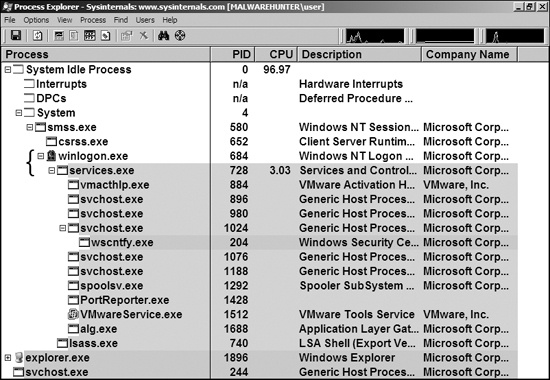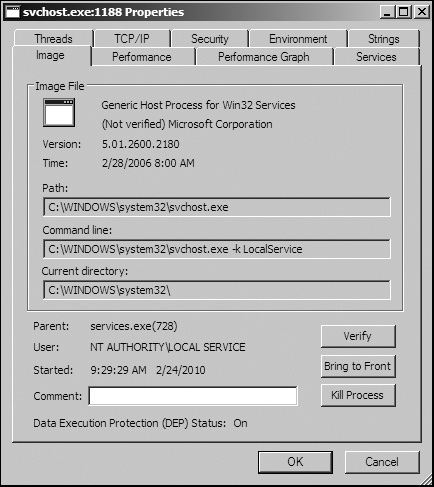The Process Explorer, free from Microsoft, is an extremely powerful task manager that should be running when you are performing dynamic analysis. It can provide valuable insight into the processes currently running on a system.
You can use Process Explorer to list active processes, DLLs loaded by a process, various process properties, and overall system information. You can also use it to kill a process, log out users, and launch and validate processes.
Process Explorer monitors the processes running on a system and shows them in a tree structure that displays child and parent relationships. For example, in Figure 3-5 you can see that services.exe is a child process of winlogon.exe, as indicated by the left curly bracket.
Process Explorer shows five columns: Process (the process name), PID (the process identifier), CPU (CPU usage), Description, and Company Name. The view updates every second. By default, services are highlighted in pink, processes in blue, new processes in green, and terminated processes in red. Green and red highlights are temporary, and are removed after the process has started or terminated. When analyzing malware, watch the Process Explorer window for changes or new processes, and be sure to investigate them thoroughly.
Process Explorer can display quite a bit of information for each process. For example, when the DLL information display window is active, you can click a process to see all DLLs it loaded into memory. You can change the DLL display window to the Handles window, which shows all handles held by the process, including file handles, mutexes, events, and so on.
The Properties window shown in Figure 3-6 opens when you double-click a process name. This window can provide some particularly useful information about your subject malware. The Threads tab shows all active threads, the TCP/IP tab displays active connections or ports on which the process is listening, and the Image tab (opened in the figure) shows the path on disk to the executable.
One particularly useful Process Explorer feature is the Verify button on the Image tab. Click this button to verify that the image on disk is, in fact, the Microsoft signed binary. Because Microsoft uses digital signatures for most of its core executables, when Process Explorer verifies that a signature is valid, you can be sure that the file is actually the executable from Microsoft. This feature is particularly useful for verifying that the Windows file on disk has not been corrupted; malware often replaces authentic Windows files with its own in an attempt to hide.
The Verify button verifies the image on disk rather than in memory, and it is useless if an attacker uses process replacement, which involves running a process on the system and overwriting its memory space with a malicious executable. Process replacement provides the malware with the same privileges as the process it is replacing, so that the malware appears to be executing as a legitimate process, but it leaves a fingerprint: The image in memory will differ from the image on disk. For example, in Figure 3-6, the svchost.exe process is verified, yet it is actually malware. We’ll discuss process replacement in more detail in Chapter 12.
One way to recognize process replacement is to use the Strings tab in the Process Properties
window to compare the strings contained in the disk executable (image) against the strings in memory
for that same executable running in memory. You can toggle between these string views using the
buttons at the bottom-left corner, as shown in Figure 3-7. If the two string listings are drastically
different, process replacement may have occurred. This string discrepancy is displayed in Figure 3-7. For example, the string FAVORITES.DAT appears multiple times in the right half of the figure
(svchost.exe in memory), but it cannot be found in the left half of the figure
(svchost.exe on disk).
Process Explorer allows you to launch depends.exe (Dependency Walker) on a running process by right-clicking a process name and selecting Launch Depends. It also lets you search for a handle or DLL by choosing Find ▶ Find Handle or DLL.
The Find DLL option is particularly useful when you find a malicious DLL on disk and want to know if any running processes use that DLL. The Verify button verifies the EXE file on disk, but not every DLL loaded during runtime. To determine whether a DLL is loaded into a process after load time, you can compare the DLL list in Process Explorer to the imports shown in Dependency Walker.
You can also use Process Explorer to analyze malicious documents, such as PDFs and Word documents. A quick way to determine whether a document is malicious is to open Process Explorer and then open the suspected malicious document. If the document launches any processes, you should see them in Process Explorer, and be able to locate the malware on disk via the Image tab of the Properties window.
Note
Opening a malicious document while using monitoring tools can be a quick way to determine whether a document is malicious; however, you will have success running only vulnerable versions of the document viewer. In practice, it is best to use intentionally unpatched versions of the viewing application to ensure that the exploitation will be successful. The easiest way to do this is with multiple snapshots of your analysis virtual machine, each with old versions of document viewers such as Adobe Reader and Microsoft Word.



